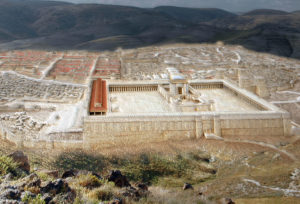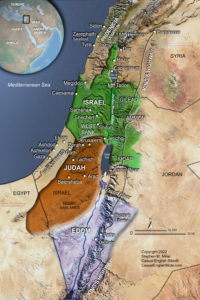Obadiah is the shortest book in the Bible because it doesn’t take long to warn people that God is going to exterminate their nation—kill it so dead that it never comes back. It takes only one chapter, about as long as Abraham Lincoln’s famously short Gettysburg Address.
I just finished paraphrasing it for the Casual English Bible, and creating some new maps to help people visualize the nation of Edom, in what is now the southwest part of the country of Jordan.
Obadiah said God was dooming Edom for collaborating with invaders who conquered the Jewish nation, leveled Jerusalem, and deported the Jewish survivors…all of which wiped Israel off the world map.
The prophet didn’t say who the invaders were, but only two nations destroyed Jerusalem: Babylon in 586 BC and Rome in AD 70. So, the common presumption is that Obadiah was talking about the Babylonian invasion.
But Obadiah didn’t identify the invaders by name, perhaps because they weren’t the target of the prophecy. Edom was.
Charges against Edom:
- Collaborating with invaders who decimated Jerusalem
- Gloating over the fall of the Israelite nation
- Arresting people of Judah as they tried to escape
- Turning them over to the enemy
- Pillaging Jerusalem’s ruins for leftover valuables
Nothing left but their shame
Obadiah said,
“All that will be left of Edom
Is the shame of what you did” (Obadiah 1:10, Casual English Bible).
 Mapping Edom
Mapping Edom
One of the maps I created about Edom—the featured map for this article—shows a bowling-pin view of the 100-mile (165 km) alley between Edom in the east and Israelites in the west: Arabah Valley, 15 miles (25 km) wide.
The Valley forms the bone-dry southern version of the Jordan River Valley, with the Dead Sea in between. The fertile Jordan River Valley lies north of the Dead Sea. The dry Arabah Valley stretches 100 miles south, to the Red Sea’s Gulf of Aqaba.
For a time, Edom controlled both sides of the valley, punching into the most barren land west of the trench. But Edom made its headquarters in the rocky hills more than a mile above the eastern slopes of the valley.
Those hills offered great natural defenses. To get into the city of Petra, for example, an attacking army had to funnel their charge through a narrow pass between high cliffs left and right. It didn’t take many defenders to plug that hole.
Obadiah warned that the people of Edom were too cocky about that:
“Your pride has warped your sense of reality.
You live protected behind natural barriers,
Walls of sheer rock chiseled into mountains.
You brag about it with a rhetorical question:
‘Who could break through our defenses?’” (Obadiah 1:3, Casual English Bible)
Obadiah said he would answer that question on God’s behalf:
“You live high in those hills, like a soaring eagle.
You’ve built your nest in the stars.
But the higher you fly, the further you’ll fall.
I’m the LORD, and I’m taking you down” (Obadiah 1:4, Casual English Bible).
An Arab tribe conquered Edom: Nabataeans. They settled into Petra and then made neighboring Bosrah their capital.
If you like Bible maps, check out the Casual English Bible’s map search engine.
Casual English Bible
Steve’s Bible-background YouTube Channel
More feature articles
Bible Gateway


 Mapping Edom
Mapping Edom
I taught a series of lessons in my Sunday School class on the Minor Prophets, they were on Power Point, and I was pleased with the results. When it came to Obadiah, there was little I could say but use another’s observation. If we somehow discovered Obadiah for the first time in a desert monastery, we surely would not have thought of this as a holy book deserving a place in our canon. I don’t remember who said it first.
Well, there’s a lot of mystery about the writers behind most Bible books, especially those written nearly 3,000 years ago. In God we trust.